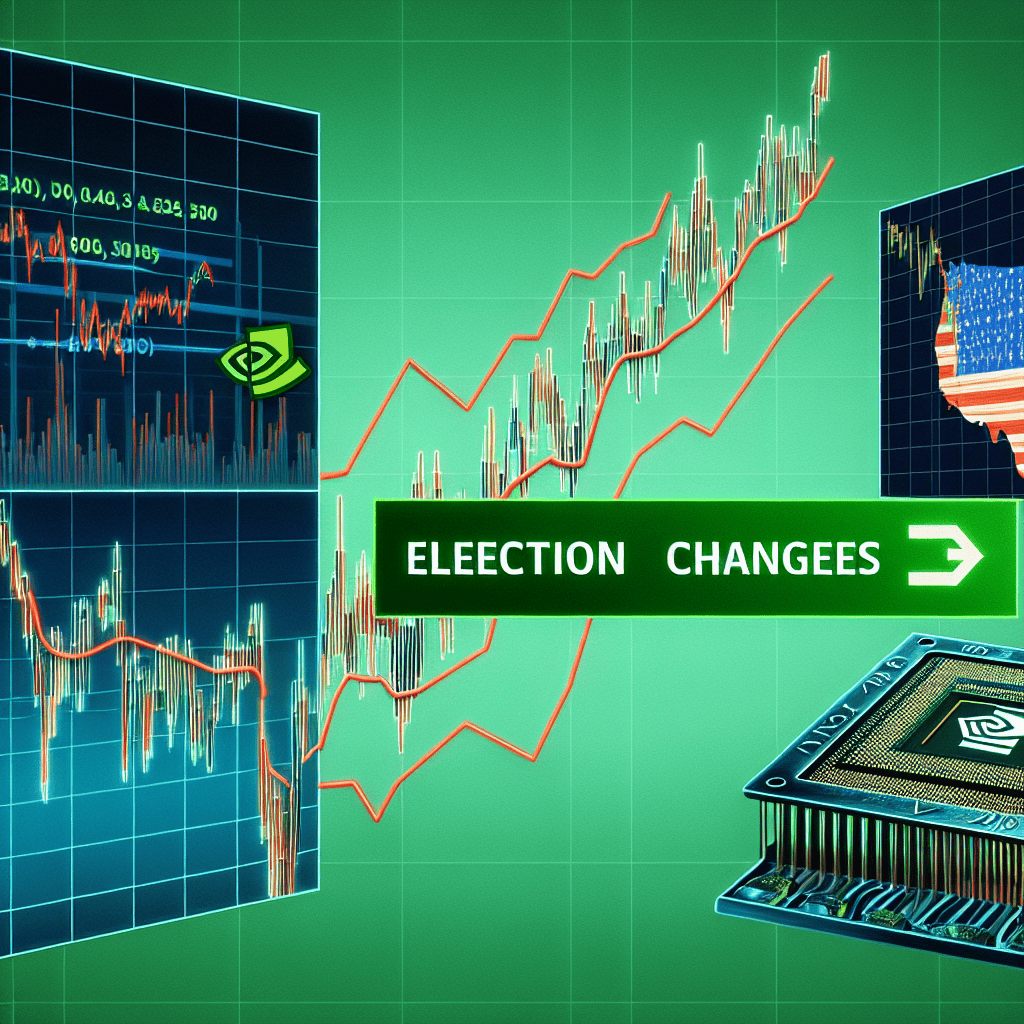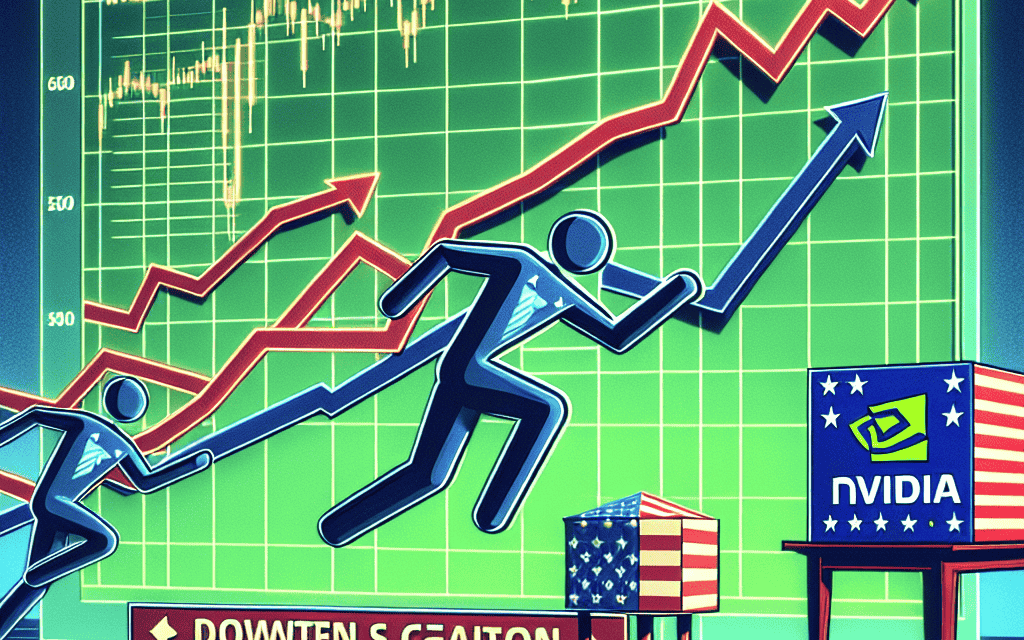“Market Shifts: Dow Futures Dip on Election News, S&P 500 Eyes Gains, Nvidia Joins the Dow”
Introduction
Dow Jones futures experienced a decline amid significant election changes, signaling potential volatility in the market. Despite this downturn, major gains are anticipated for the S&P 500, reflecting investor optimism in certain sectors. Additionally, Nvidia, a leading technology company, is poised to join the Dow Jones Industrial Average, marking a significant shift in the index’s composition. This move underscores the growing influence of tech companies in the broader market landscape, as investors closely monitor these developments for potential impacts on their portfolios.
Impact Of Election Changes On Dow Jones Futures
The recent decline in Dow Jones futures has captured the attention of investors and analysts alike, as election changes introduce a new layer of uncertainty to the financial markets. This development comes at a time when the S&P 500 is poised for significant gains, and Nvidia is set to make its entry into the Dow, further complicating the investment landscape. Understanding the interplay between these factors is crucial for stakeholders aiming to navigate the evolving market dynamics.
Election changes often bring about a period of volatility in financial markets, as investors reassess their strategies in response to potential shifts in economic policy and regulatory frameworks. The current decline in Dow Jones futures can be attributed, in part, to the anticipation of such changes. As political landscapes shift, market participants are keenly aware that new policies could impact sectors differently, leading to a reallocation of assets. This reallocation can result in short-term fluctuations, as seen in the recent futures decline.
Despite the immediate uncertainty, the broader outlook for the S&P 500 remains optimistic. Analysts predict major gains for the index, driven by strong corporate earnings and a resilient economic recovery. The S&P 500, which represents a diverse cross-section of industries, is well-positioned to benefit from sectors that are expected to thrive under new policy directions. For instance, technology and renewable energy companies may see increased investment as governments prioritize innovation and sustainability. This potential for growth underscores the importance of maintaining a long-term perspective, even amid short-term market disruptions.
Adding another layer of complexity to the current market environment is Nvidia’s impending inclusion in the Dow Jones Industrial Average. Nvidia, a leader in the semiconductor industry, is set to replace a longstanding member of the index, marking a significant shift in the composition of the Dow. This change reflects the growing importance of technology companies in the modern economy and highlights the evolving nature of traditional market indices. Nvidia’s entry is expected to bring increased attention to the semiconductor sector, which has been a key driver of technological advancement and economic growth.
The inclusion of Nvidia in the Dow is likely to have a ripple effect across the market, as investors adjust their portfolios to account for the new composition of the index. This adjustment process may contribute to short-term volatility, as seen in the recent decline in Dow Jones futures. However, it also presents opportunities for investors to capitalize on emerging trends and sectors that are poised for growth. As such, market participants are encouraged to stay informed and agile, ready to adapt to the changing landscape.
In conclusion, the decline in Dow Jones futures amid election changes, coupled with the anticipated gains in the S&P 500 and Nvidia’s entry into the Dow, presents a complex but potentially rewarding scenario for investors. While short-term volatility is to be expected, the underlying fundamentals of the market remain strong, offering opportunities for those who are prepared to navigate the challenges and capitalize on the opportunities that lie ahead. By maintaining a balanced perspective and staying attuned to market developments, investors can position themselves to benefit from the evolving economic landscape.
Analyzing The S&P 500’s Potential For Major Gains
The financial landscape is witnessing a dynamic shift as Dow Jones futures experience a decline amid significant election changes, while the S&P 500 is poised for substantial gains. This intriguing juxtaposition of market movements invites a closer examination of the factors influencing these trends and the potential implications for investors. As the political climate evolves, market participants are keenly observing how these changes might impact economic policies and, consequently, the stock market. The anticipation surrounding the S&P 500’s potential for major gains is fueled by a combination of economic indicators, corporate earnings, and strategic shifts within major companies.
One of the pivotal factors contributing to the optimism surrounding the S&P 500 is the robust performance of key sectors, particularly technology. Companies within this sector have consistently demonstrated resilience and innovation, driving growth and investor confidence. Notably, Nvidia, a leader in the semiconductor industry, is set to make a significant entry into the Dow Jones Industrial Average. This move underscores the growing importance of technology companies in shaping the future of the market. Nvidia’s inclusion is expected to bring a fresh wave of interest and investment, potentially bolstering the S&P 500’s performance.
Moreover, the broader economic environment is showing signs of recovery, with consumer spending and employment figures indicating a positive trajectory. These factors contribute to a favorable backdrop for the S&P 500, as increased consumer confidence often translates into higher corporate revenues and profits. Additionally, the Federal Reserve’s monetary policy continues to play a crucial role in shaping market expectations. With interest rates remaining relatively low, borrowing costs are minimized, encouraging business expansion and investment. This monetary environment is conducive to stock market growth, further supporting the potential for gains in the S&P 500.
Transitioning to the implications of election changes, it is essential to consider how shifts in political leadership and policy priorities might influence market dynamics. Historically, elections have introduced a degree of uncertainty, as investors assess the potential impact of new policies on various sectors. However, this uncertainty can also present opportunities for strategic investments, particularly in industries poised to benefit from anticipated policy changes. As the political landscape stabilizes, clarity regarding regulatory and fiscal policies will likely emerge, providing a more predictable environment for investors.
In light of these developments, market analysts are closely monitoring corporate earnings reports, which serve as a barometer for the health of the economy and the stock market. Strong earnings results can reinforce investor confidence and drive further gains in the S&P 500. Conversely, any signs of weakness or missed expectations could temper enthusiasm and introduce volatility. Therefore, investors are advised to maintain a balanced perspective, considering both the opportunities and risks inherent in the current market environment.
In conclusion, the interplay between election changes, economic indicators, and corporate performance is shaping a complex yet promising outlook for the S&P 500. While the decline in Dow Jones futures may signal caution, the potential for major gains in the S&P 500 remains compelling. As Nvidia prepares to enter the Dow, its influence, along with broader market trends, will be pivotal in determining the trajectory of the stock market. Investors are encouraged to stay informed and agile, ready to capitalize on emerging opportunities while navigating the challenges that lie ahead.
Nvidia’s Entry Into The Dow: What It Means For Investors
The recent announcement of Nvidia’s impending entry into the Dow Jones Industrial Average has captured the attention of investors and market analysts alike. This development comes at a time when the Dow Jones futures are experiencing a decline amid significant election changes, yet the S&P 500 is poised for major gains. As Nvidia prepares to join the ranks of the Dow, it is essential to understand the implications of this move for investors and the broader market.
Nvidia, a leading player in the semiconductor industry, has been at the forefront of technological innovation, particularly in the fields of artificial intelligence and graphics processing. Its inclusion in the Dow Jones Industrial Average is a testament to its growing influence and market capitalization. This move is expected to bring a fresh wave of interest from institutional investors who track the Dow, potentially leading to increased demand for Nvidia’s shares. Consequently, this could result in a positive impact on Nvidia’s stock price, benefiting existing shareholders and attracting new investors.
Moreover, Nvidia’s entry into the Dow signifies a shift in the composition of the index, reflecting the evolving landscape of the global economy. Traditionally dominated by industrial and financial companies, the Dow’s inclusion of a tech giant like Nvidia underscores the increasing importance of technology in driving economic growth. This shift is indicative of a broader trend where technology companies are becoming central to the market, influencing investment strategies and portfolio allocations.
In addition to its impact on Nvidia, this development is likely to have broader implications for the Dow Jones Industrial Average itself. The inclusion of a high-growth tech company like Nvidia could potentially enhance the performance of the index, especially if Nvidia continues its trajectory of innovation and market expansion. This could make the Dow more attractive to investors seeking exposure to the technology sector, which has been a significant driver of market gains in recent years.
However, it is important to consider the potential challenges that may arise from this transition. The volatility often associated with technology stocks could introduce new dynamics to the Dow, which has traditionally been viewed as a stable and reliable index. Investors may need to adjust their expectations and strategies accordingly, taking into account the increased potential for fluctuations in the index’s performance.
Furthermore, Nvidia’s entry into the Dow comes at a time of political uncertainty, with election changes influencing market sentiment. While the S&P 500 is expected to see major gains, the decline in Dow Jones futures highlights the complexities of the current economic environment. Investors must navigate these challenges with caution, balancing the opportunities presented by Nvidia’s inclusion with the broader market dynamics at play.
In conclusion, Nvidia’s entry into the Dow Jones Industrial Average marks a significant milestone for the company and the index. It reflects the growing prominence of technology in the global economy and offers potential benefits for investors seeking exposure to this dynamic sector. However, it also introduces new considerations for market participants, who must remain vigilant in the face of evolving market conditions and political uncertainties. As Nvidia takes its place among the Dow’s elite, investors will be closely watching to see how this move shapes the future of the index and the broader market landscape.
Election Volatility: How It Affects Dow Jones Futures

The financial markets are often sensitive to political events, and the recent election changes have been no exception. As the political landscape shifts, investors are closely monitoring the implications for the economy and, consequently, the stock market. In particular, Dow Jones futures have experienced a decline amid these election changes, reflecting the uncertainty that often accompanies such transitions. This volatility is not unusual, as markets tend to react to the potential for new policies and regulations that could impact various sectors. Investors are keenly aware that political shifts can lead to changes in fiscal policy, trade agreements, and regulatory environments, all of which can have significant effects on market performance.
Despite the current decline in Dow Jones futures, there is optimism in the air regarding the broader market. Analysts are predicting major gains for the S&P 500, driven by strong corporate earnings and a resilient economy. The S&P 500, which is a more comprehensive index than the Dow, often provides a clearer picture of the overall market health. As companies continue to report robust earnings, investor confidence is bolstered, leading to expectations of upward momentum in the index. This optimism is further fueled by the anticipation of continued economic recovery, as businesses adapt to the post-pandemic landscape and consumer spending remains strong.
In addition to these broader market dynamics, specific developments within the Dow Jones Industrial Average are capturing investor attention. Notably, Nvidia, a leading technology company, is set to enter the Dow. This inclusion is significant, as it reflects the growing importance of technology companies in the modern economy. Nvidia’s addition to the Dow is expected to bring a fresh wave of interest and investment into the index, as the company is renowned for its innovation in graphics processing units and artificial intelligence. The inclusion of such a dynamic company is likely to enhance the performance of the Dow, providing a counterbalance to the current volatility.
Moreover, the potential for major S&P 500 gains and Nvidia’s entry into the Dow highlight the evolving nature of the stock market. As traditional industries give way to technology-driven growth, indices like the Dow and S&P 500 are adapting to better represent the economic landscape. This evolution is crucial for investors seeking to understand and navigate the complexities of the market. By staying informed about these changes, investors can make more strategic decisions, positioning themselves to capitalize on emerging opportunities.
In conclusion, while election changes have introduced a degree of volatility to Dow Jones futures, the overall outlook for the market remains positive. The anticipated gains in the S&P 500, coupled with Nvidia’s entry into the Dow, underscore the resilience and adaptability of the market. As investors navigate this period of transition, they are reminded of the importance of staying informed and agile in their investment strategies. By doing so, they can better manage the risks associated with political and economic changes, while also seizing the opportunities that arise in a dynamic market environment.
S&P 500’s Growth Prospects Amid Market Shifts
The financial landscape is witnessing significant shifts as Dow Jones futures experience a decline amid notable election changes, while the S&P 500 is poised for substantial gains. This dynamic environment is further complicated by Nvidia’s anticipated entry into the Dow, a move that could have far-reaching implications for investors and market analysts alike. As these developments unfold, it is crucial to understand the underlying factors driving these changes and their potential impact on the broader market.
To begin with, the decline in Dow Jones futures can be attributed to a confluence of political and economic factors. Recent election changes have introduced a degree of uncertainty, prompting investors to reassess their strategies. Historically, markets tend to react to political shifts with caution, as policy changes can influence economic conditions and corporate profitability. In this context, the current decline in futures may reflect investor apprehension about potential regulatory adjustments and fiscal policies that could emerge from the new political landscape.
Despite the challenges facing the Dow, the S&P 500 is expected to experience significant gains. This optimism is largely driven by the robust performance of key sectors such as technology, healthcare, and consumer discretionary. These industries have demonstrated resilience and adaptability in the face of economic headwinds, positioning them for continued growth. Moreover, the S&P 500’s diverse composition allows it to benefit from a broad range of economic activities, providing a buffer against sector-specific downturns.
In addition to sectoral strength, the anticipated inclusion of Nvidia in the Dow is generating considerable interest. Nvidia, a leader in the semiconductor industry, has consistently delivered impressive financial results, driven by its innovative products and strategic acquisitions. Its entry into the Dow is expected to enhance the index’s exposure to the burgeoning technology sector, which has been a key driver of market growth in recent years. This move could also attract a new wave of investors seeking to capitalize on Nvidia’s growth potential, thereby boosting overall market sentiment.
Furthermore, the potential gains in the S&P 500 are supported by favorable macroeconomic conditions. Despite ongoing challenges such as inflationary pressures and supply chain disruptions, the U.S. economy continues to exhibit signs of recovery. Strong consumer spending, coupled with robust corporate earnings, has bolstered investor confidence, creating a conducive environment for market growth. Additionally, the Federal Reserve’s monetary policy stance remains accommodative, providing further support for equities.
As we navigate these market shifts, it is essential for investors to remain vigilant and informed. While the S&P 500’s growth prospects appear promising, the inherent volatility of financial markets necessitates a cautious approach. Diversification remains a key strategy for mitigating risk, allowing investors to capitalize on opportunities across different sectors and asset classes. Moreover, staying abreast of geopolitical developments and economic indicators can provide valuable insights into potential market trends.
In conclusion, the current market environment presents a complex interplay of challenges and opportunities. The decline in Dow Jones futures amid election changes underscores the importance of political stability in shaping investor sentiment. Meanwhile, the S&P 500’s growth prospects, bolstered by sectoral strength and favorable economic conditions, offer a beacon of optimism. As Nvidia prepares to enter the Dow, its impact on the market will be closely watched, potentially setting the stage for further developments in the financial landscape.
Strategic Insights On Nvidia Joining The Dow
The financial landscape is poised for significant shifts as Dow Jones futures experience a decline amid recent election changes, while major gains are anticipated for the S&P 500. A pivotal development in this evolving scenario is the expected inclusion of Nvidia in the Dow Jones Industrial Average, a move that could have far-reaching implications for investors and the broader market. As we delve into the strategic insights surrounding Nvidia’s anticipated entry into the Dow, it is essential to consider the broader context of these market dynamics.
The Dow Jones Industrial Average, a benchmark index that tracks 30 prominent companies listed on stock exchanges in the United States, is often seen as a barometer of the overall health of the U.S. economy. The inclusion of a company in this prestigious index is not merely symbolic; it reflects the company’s significant influence and stability within the market. Nvidia, a leading player in the technology sector, has demonstrated remarkable growth and innovation, particularly in areas such as artificial intelligence, gaming, and data centers. Its potential addition to the Dow underscores the increasing importance of technology companies in driving economic growth and shaping the future of industries.
Transitioning to the implications of this development, Nvidia’s entry into the Dow could lead to increased visibility and credibility for the company, attracting a broader base of investors. This move is likely to enhance Nvidia’s profile among institutional investors who track the Dow closely, potentially leading to increased demand for its shares. Moreover, the inclusion of Nvidia could also prompt a rebalancing of portfolios by fund managers, as they adjust their holdings to align with the updated composition of the index. This rebalancing could result in increased trading volumes and volatility in the short term, as market participants respond to the changes.
Furthermore, Nvidia’s anticipated inclusion in the Dow comes at a time when the S&P 500 is expected to experience significant gains. The S&P 500, which comprises 500 of the largest companies listed on U.S. stock exchanges, is often viewed as a more comprehensive indicator of the market’s performance. The expected gains in the S&P 500 suggest a positive outlook for the broader market, driven by factors such as strong corporate earnings, economic recovery, and investor optimism. Nvidia’s strong performance and growth prospects align well with this positive sentiment, reinforcing its potential impact on the market.
In addition to these market dynamics, the recent election changes have introduced an element of uncertainty, contributing to the decline in Dow Jones futures. Political developments can have a profound impact on investor sentiment, influencing market trends and shaping economic policies. As investors navigate this complex landscape, the strategic insights surrounding Nvidia’s entry into the Dow become even more critical. By understanding the potential implications of this development, investors can make informed decisions and position themselves to capitalize on emerging opportunities.
In conclusion, the anticipated inclusion of Nvidia in the Dow Jones Industrial Average represents a significant milestone for the company and the broader market. As Dow Jones futures decline amid election changes and major gains are expected for the S&P 500, Nvidia’s entry into the Dow highlights the growing influence of technology companies in shaping the future of the economy. By considering the strategic insights surrounding this development, investors can better navigate the evolving financial landscape and make informed decisions to achieve their investment goals.
Navigating Market Changes: Dow Jones Futures And Election Dynamics
In the ever-evolving landscape of financial markets, the Dow Jones futures have recently experienced a decline, a movement that coincides with significant changes in the political arena. As investors navigate these shifts, the interplay between market dynamics and political developments becomes increasingly crucial. The recent election changes have introduced a layer of uncertainty, prompting market participants to reassess their strategies and expectations. This decline in Dow Jones futures is not an isolated event but rather a reflection of broader market sentiments influenced by political transitions.
Amidst this backdrop, the S&P 500 is poised for substantial gains, suggesting a divergence in market trajectories. The anticipation of major gains in the S&P 500 can be attributed to several factors, including robust corporate earnings and a resilient economic outlook. Investors are closely monitoring these indicators, as they provide a counterbalance to the uncertainties surrounding the Dow Jones futures. The resilience of the S&P 500 underscores the market’s ability to adapt and thrive even in the face of political and economic challenges.
Adding another layer of complexity to the current market scenario is the impending inclusion of Nvidia in the Dow Jones Industrial Average. Nvidia’s entry into this prestigious index marks a significant milestone, reflecting the growing influence of technology companies in shaping market trends. As a leader in the semiconductor industry, Nvidia’s inclusion is expected to bring a fresh dynamic to the Dow, potentially influencing its future performance. This development highlights the evolving nature of the Dow Jones Industrial Average, which continues to adapt to the changing economic landscape by incorporating companies that are at the forefront of innovation.
The intersection of these factors—election changes, S&P 500 gains, and Nvidia’s entry into the Dow—creates a complex environment for investors. Navigating this landscape requires a nuanced understanding of how political developments can impact market sentiment and how individual companies can drive broader market trends. Investors are advised to remain vigilant, keeping a close eye on both macroeconomic indicators and company-specific developments.
Moreover, the current scenario underscores the importance of diversification in investment strategies. As different indices and sectors respond variably to political and economic changes, a diversified portfolio can help mitigate risks and capitalize on opportunities. Investors are encouraged to consider a balanced approach, taking into account both the potential gains in the S&P 500 and the evolving dynamics of the Dow Jones Industrial Average.
In conclusion, the decline in Dow Jones futures amid election changes, coupled with the expected gains in the S&P 500 and Nvidia’s entry into the Dow, presents a multifaceted challenge for investors. As they navigate these changes, a comprehensive understanding of market dynamics and a strategic approach to investment will be essential. By staying informed and adaptable, investors can position themselves to effectively manage risks and seize opportunities in this dynamic market environment. The interplay between political developments and market trends will continue to shape the financial landscape, making it imperative for investors to remain proactive and informed.
Q&A
1. **What caused the decline in Dow Jones Futures?**
The decline in Dow Jones Futures was attributed to uncertainties and changes related to recent elections.
2. **What are the expected gains for the S&P 500?**
Major gains are expected for the S&P 500, driven by positive market sentiment and strong performance from key sectors.
3. **Which company is set to enter the Dow?**
Nvidia is set to enter the Dow, reflecting its growing influence and market capitalization.
4. **How might Nvidia’s entry into the Dow impact the index?**
Nvidia’s entry could potentially boost the Dow due to its strong performance and significant market value.
5. **What sectors are contributing to the S&P 500’s expected gains?**
Technology and consumer discretionary sectors are among those contributing to the expected gains in the S&P 500.
6. **How do election changes typically affect market futures?**
Election changes can lead to market volatility as investors react to potential policy shifts and economic implications.
7. **What is the significance of Nvidia joining the Dow?**
Nvidia joining the Dow signifies its importance in the tech industry and its impact on the broader market.
Conclusion
The decline in Dow Jones Futures amid election changes suggests market uncertainty and potential volatility, reflecting investor concerns over political developments. Despite this, major gains in the S&P 500 indicate underlying strength in the broader market, possibly driven by positive economic indicators or corporate earnings. Nvidia’s anticipated entry into the Dow highlights its growing influence and the increasing importance of technology companies in the market. Overall, while short-term fluctuations are expected due to political factors, the long-term outlook remains optimistic with significant growth potential in key sectors.





